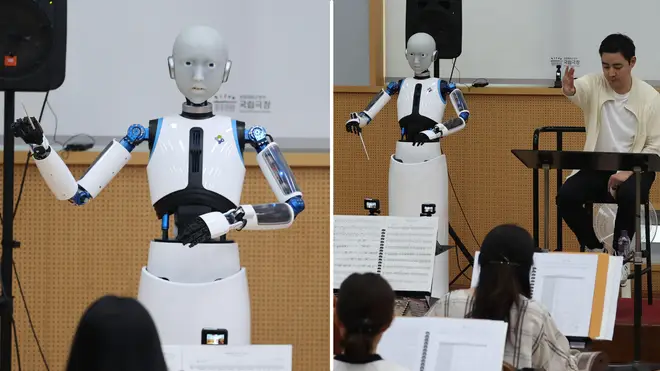Robot conductor gives a history-making orchestral debut in South Korea
3 July 2023, 13:50

South Korea asks ‘Can robots replace conductors?’, as a mechanical maestro makes its podium debut...
Listen to this article
A robot has become the first of its kind to conduct an orchestra in South Korea, in a high-profile concert hall debut last week.
Standing at 1.8 metres tall, the EveR 6 robot led the National Orchestra of Korea in a sold-out performance at the National Theatre of Korea in Seoul on Friday 30 June.
The legless automaton was developed by the Korean Institute of Industrial Technology over a year ago, to test whether ‘robots could replace conductors’. Equipped with two arms housing ‘wrist’ and ‘elbow’ joints, the machine is able to delicately replicate the baton movements of the human maestro.
In a video advertisement for last Friday’s performance, a senior researcher at the Korean Institute of Industrial Technology, Dong-wook Lee, explained: “We got involved in this project to see how far robots can go in more creative fields like the arts, and what the challenges are.”
The concert, titled Disproof, was conducted by both the EverR 6 and a human conductor, Soo-yeol Choi – the artistic director of the Busan Philharmonic Orchestra. Both maestros performed separately, before coming together at the end of the concert to conduct together (watch below).
Read more: Giant humanoid robot conducts human orchestra in mildly disturbing footage
Composed especially for the event, the piece of music which saw both human and artificial conductors come together was a 12-minute work, Feel, written by Il-hoon Son.
Son’s work purposefully utilised both of the conductors’ strengths, as the score featured no musical notation.
Instead, the robot was preprogrammed to conduct through 30 cycles of beat patterns, while the human conductor led the ensemble through an improvisational score, responding in real time and communicating with the performers where the piece was going next.
In a post on Instagram ahead of the concert, Son suggested that his work opened up possibilities for the coming together of man and machine, “through creative collaboration,” he wrote, “not opposition”.
Read more: Watch the piano-playing robot developed by leading AI lab that can also read human emotions

국립국악관현악단 관현악시리즈Ⅳ '부재(不在)' | 메이킹 필름 Making Film
To get the mechanical maestro ready for its performance, the team at the Korean Institute of Industrial Technology used motion-capture technology to replicate the movements of the National Orchestra of Korea’s assistant conductor, Yeji Jeong.
All the EveR 6’s movements were preprogrammed, meaning there was no room for improvisation within the piece, which Son’s work calls on the human conductor to do. The robot also cannot hear and does not use generative artificial intelligence.
Programmers from the Korean Institute of Industrial Technology have said the next stage in the robot’s development could be the addition of data learning, so orchestras could ask the cybernetic conductor for a specific tempo or beat pattern.
However, conducting is so much more than just beating a rhythm, and Choi, who worked alongside the EverR 6 does not think a robot could replace him, or any other human on the podium.
“Let’s leave the accuracy to the robots,” Choi related in a video interview with the national theatre prior to the performance.
“But the musical and artistic aspects to a human conductor.”


































